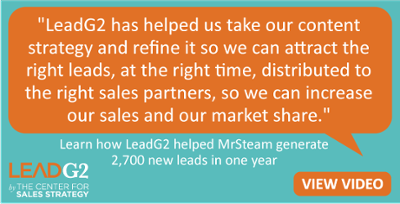The Top 3 Reasons We're Thankful for Inbound Marketing
It's Thanksgiving week, which is a time to reflect on all of the things that make you happy, contribute to your success, and help you to grow. So in...


When we picture lead generation working the way we think it should, most of us envision the salesperson being handed a fully qualified lead and only a small step from closing. We want the process to be predictable and the performance to be near perfect.
If only the real world were so simple and straightforward. You remember the real world—where humans act human and analysis turns murky. Below are seven ways to calculate blog ROI; in other words, is it generating a return on your investment, and is the company blog really working?
 The usual equation for return on investment (ROI) is simple: revenue earned from the investment minus the cost of the investment, divided by the cost of the investment. However, when you utilize content marketing, focusing purely on revenue to blog content ratio is not the best way to measure the effectiveness of your content.
The usual equation for return on investment (ROI) is simple: revenue earned from the investment minus the cost of the investment, divided by the cost of the investment. However, when you utilize content marketing, focusing purely on revenue to blog content ratio is not the best way to measure the effectiveness of your content.
A blog is part of the total sales funnel, not just a small piece. With a strategic content marketing plan in place, your company blog builds brand awareness, provides clients and prospects with a source of educational and valuable resources, and so much more.
We know how frustrating it is when you can't measure its direct success. That's why we're providing seven ways we track the effectiveness of blog content.
This is when a former prospect or client that had gone quiet for a few months re-engages as a result of a blog post or a piece of premium content. Top salespeople understand that messy humans, who don’t take the straight and narrow path to your door, shouldn’t be written off. Keep your eye on them as they reconvert and decide when it's time to call.
Lead intelligence is simply gathering together all the data accumulated from the lead’s activities on your site. The data lights up for you the moment the visitor first becomes a lead by providing their name and email address. Then the data can answer important questions like:
One sales leader we work with reported that they attribute their recent increase in both existing business and pending business to lead intelligence alone.
In sales, it’s about having the right information at the right time. Using the right inbound marketing tool allows you to know who is opening your blog posts and clicking on links or downloading premium content. Smart sellers know that when a prospect is engaged like that, they're already moving through the buying process.
Those humans are at it again—just when we expected an online contact, they did it the old fashioned way: they called when they were ready to talk turkey.
Picture this: One of your customers begins thinking about alternatives to buying from you (a risk that is increased if you’re not the low-price vendor). So they look online for others who deliver a similar product or service, and what do they find? You!
There’s your company on the first page of search results with multiple articles, links, and references. They realize they are working with the best and their motivation to find an alternative dries up. That’s extremely valuable ROI. Imagine if you were not doing inbound and your competition was. You could have lost a customer, and then another, and another.
Devoted blog readers see you as the expert, and they rely on you for information they find valuable. Likely the toughest ROI to track, it is also one of the most important. We all know that your best customers are also your best prospects; your blog allows you to stay in front of them in a way they find comfortable and useful. You are there exactly when they want you, and they view you as their expert.
See also: how to increase engagement on your company blog.
These prospects, clients, and connectors are the ones that share your articles, re-tweet your updates, and forward your emails. Like the daily blog reader, these prospects can be hard to spot and tricky to track. It is oh-so-common for someone to follow you on LinkedIn for six months, never download a single thing, and then one day when they need your help, they reach out directly to become a customer. Difficult to track, but truly Inbound ROI!
The ROI you get from your inbound marketing program depends on how well you use all of the resources and tools that inbound puts at your disposal. Sales organizations that maximize their Inbound ROI realize the myriad ways in which that ROI shows up.
Editor's Note: This blog was originally written December 2017 and has since been updated.

It's Thanksgiving week, which is a time to reflect on all of the things that make you happy, contribute to your success, and help you to grow. So in...

Inbound marketing attracts people who are actively interested in your offerings or brand to your business. Using SEO and other inbound tactics, you...

55 Brands who prioritize blogging efforts are 13x more likely to see positive ROI, and 55% of brands say blog content creation is their top inbound...